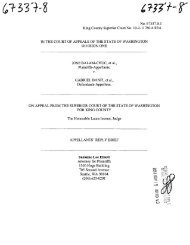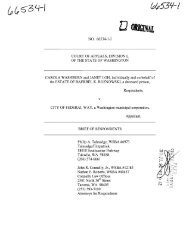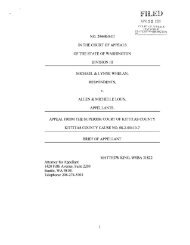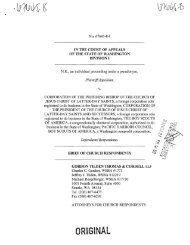Appellants' Reply Brief - Washington State Courts
Appellants' Reply Brief - Washington State Courts
Appellants' Reply Brief - Washington State Courts
You also want an ePaper? Increase the reach of your titles
YUMPU automatically turns print PDFs into web optimized ePapers that Google loves.
10/31/2006 13:OO FAX 360902""5<br />
Claims Adm. Policy Manual<br />
Policy 4.41<br />
I&I CIAAIM APPEALS<br />
Policy 4.41<br />
Effective 4-20-92<br />
--Construction workers and workers from other similar industries are<br />
considered full-time when their employment pattern shows regular and<br />
continuous employment, interrupted only by job completion and<br />
unavoidable lay-0%.<br />
when an employee works in an exclusively seasonal position, wages are<br />
calculated by dividing by twelve the total wages earned, including overtime<br />
wages, from all employment in any twelve successive calendar months<br />
preceding the injury. Calculations must be based upon employment that<br />
fairly represents the worker's employment pattern at the time of injury. The<br />
work pattern is considered exclusively seasonal when work is entirely<br />
dependent on the seasons and no other work is performed by the worker.<br />
When a worker is employed essentially part-time, wages are calculated by<br />
dividing by twelve the total wages eamed, including overtime, from all<br />
employment in any twelve successive calendar months preceding the injury.<br />
~.lc&tions must be based upon employment that fairly represents the<br />
wrrslPlwer's employment pattern at the time of injury. In essentially part-time<br />
mrk, the employee works fewer hours than ordinarily worked by other<br />
employees in that job.<br />
When a worker is employed in a regular part-time job, wages are calculated<br />
based upon the number of hours worked per day and days worked per week.<br />
This does not include overtime pay, but does include overtime hours. (See<br />
Attachment 4.41-A for an example.) In regular part-time work, employees<br />
work a set time per month, which is typical for the other employees in a<br />
similar position.<br />
When a worker is employed in intermittent employment, wages are<br />
calculated by dividing by twelve the total wages earned, including overtime,<br />
from all employment in any twelve successive calendar months preceding the<br />
injury. Calculations must be based upon employment that fairly represents<br />
the worker's employment pattern at the time of injury.<br />
Intermittent employment is not regular or continuous in the future. It may be<br />
full-time, extra-time or part-time and has definite starting and stopping points<br />
with recurring time gaps.
















